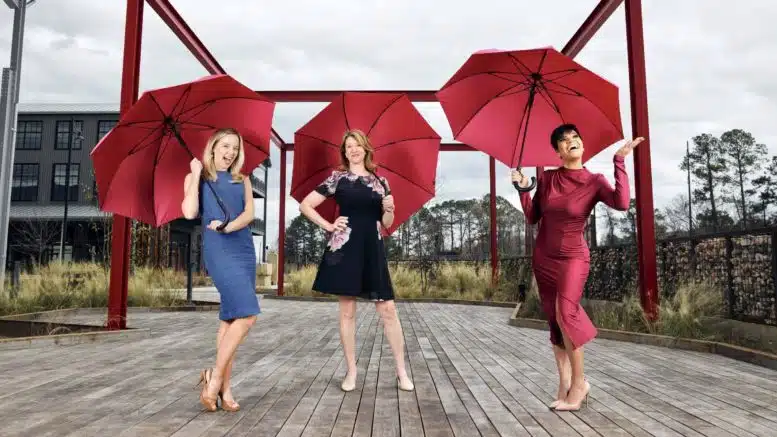All three local major network morning meteorologists are female—for the first time ever.
Alarm rings at 1:30am. On set by 3:30am. On air at 4am—until 12:30pm. (Picture the pilot of The Morning Show sans the hair and makeup artists.) It’s a grueling schedule. It’s not for the faint of heart. And, until recently, for the most part, it wasn’t for women.
Now, for the first time in our city’s history, all three local TV morning meteorologists are women. Raleigh-native Elizabeth Gardner was WRAL’s first female meteorologist in 1998; Pittsburgh-native Kweilyn Murphy joined ABC11’s Eyewitness News morning ranks in 2021; and Charlestonian Laura Smith, named as CBS 17’s weekday morning and noon meteorologist in December, rounds out the award-winning trio.
“It really is a precious space we’re functioning in,” says Murphy, “and, as women, we don’t take it for granted. I feel like sometimes we may have to work harder because we are women in a field that has been so dominated by men.”
So dominated by men in fact, women were originally devalued as “weather girls” (think the Vanna Whites of TV forecasting). Since, women have worked decades to shatter the glass ceiling and rewrite the narrative—a path paved by such women as Dr. Joanne Simpson, the first to earn a PhD in meteorology and first female president of the American Meteorological Society, who spearheaded efforts to boost female and minority presence in physical sciences. And, breaking the broadcast barrier, industry pioneer June Bacon-Bercey was the first African American to earn a meteorology degree in 1954—after being told at UCLA that maybe she should consider home economics instead because meteorology was not a career for women to pursue—and the first ever on-air female meteorologist in 1971.
Some 50 years later, those barriers are still being broken. “We have certainly settled into our space,” says Murphy. “We own the ground we stand on.” It’s a tide change we see playing out on the national stage. Good Morning America and the Today show are now forecasted by females. While the paradigm shift can no doubt be attributed to changing attitudes, all three local leading ladies attribute the shifting climate to education.
“Ever since I got into this business, companies have been really looking for women—which is a wonderful thing,” says Gardner. “But there just haven’t been as many women out there as people would like to hire. It wasn’t something you were pushed toward when you were growing up in school.”
Echoes Smith: “Teachers didn’t really push women to go into science.” But that tide, too, is changing thanks to STEM. (Read: Women are no longer being encouraged to concentrate on “more realistic careers” like home ec.) “The STEM-focused programs are incredibly important and introduce girls to science, technology, engineering and math, and get their confidence up—teaching girls you can do this and not to shy away from it,” says Murphy. “STEM is something more women are encouraged to go into,” adds Smith, “and we’re starting to see that wave—and it’s exciting.”
But these female scientists don’t just represent another shattered glass ceiling. They are themselves the change. The “If you can see it, you can be it.” And for viewers everywhere—especially young impressionable ones who will have never seen anyone different broadcast their morning weather—female scientists are becoming standardized.
That said, we still have a long way to go. It’s worth noting that maybe the grueling morning slots are easier for female meteorologists who may have children at home. Or that ~76% of broadcast meteorologists are still men, according to data released in September. Or that these women’s inboxes are filled on the daily with commentary on their appearance—despite the fact that next to no one writes in to comment on their male counterparts’ tie colors or socks or shoes.
But these well-educated and well-meaning forecasters are more focused on informing the public and on their role working with school children and the community—and, when the time comes, saving lives—than their “outfit of the day.” “Ijust let it roll off my back,” says Murphy, as Gardner and Smith nod in agreement. “One time a viewer said, Kweilyn has on pants today,’ and I replied, ‘So does John Clark!’” (which the entire interview room full of females cheered upon hearing). “People see us, love the dresses, talk about our hair, our makeup,” she adds, “but the goal is informing and safety.”
“It’s definitely part of the job—you’ve just gotta let it go,” adds Smith, who acknowledges a new New York Fashion Show runway tennis shoes trend after Gardner enviously comments on some morning men newscasters wearing running shoes on air. “I want to wear my Vans,” she jokes (to which we all say—“Do it!”).
Perhaps the next glass ceiling shattered? When these female scientists receive emails of gratitude for saving your life while broadcasting in sneakers you didn’t even notice to comment on. Until then, at least when you wake up, your weather report is being forecasted by a female.

